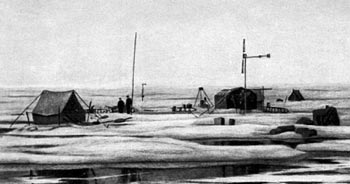|
History
North Pole Drifting Stations (1930s-1980s)
A remarkable expedition was accomplished
by the USSR just prior to the start of World Wor II, led by
political officer Ivan Papanin. From a starting base on Rudolf
Island in Frantz Josef Land, an aircraft expedition was deployed
to the North Pole and a research camp established on the drifting
ice in the vicinity of the pole. For communications, a radio
beacon was installed, and for resupply, a landing strip was
prepared.
The fleet of four heavy and one light aircraft departed Moscow
in March 1937 under the command of Otto Schmidt. In May, the
aircraft of aviator Vodopianov reached the North Pole, passed
it and landed on an ice floe about 3 m thick and 4 km2
in area at latitude 89°26'N. In a few days, three more aircraft
landed. A little more than a week later all of the aircraft
returned to base, leaving four hardy explorers: Papanin, the
chief of the station; Peter Shirshov, the hydro biologist; Eugeny
Fedorov, astronomer and meteorologist; and radio operator Ernest
Krenkel.
The drift continued for 274 days, during which the station travelled
more than 2600 km, obtaining the first scientific observations
from that high latitude. The crew regularly measured ocean depth,
took bottom soil samples, measured water temperature, took water
samples from different levels, and carried out meteorological
observations. In February 1938 the "North Pole" station drifted
out to the Greenland Sea, and after several attempts, the camp
was evacuated successfully with the help of an icebreaker.
 |
 |
| "North Pole" station in summer 1937. Image courtesy Ecoshelf. |
|
The expedition proved that there were neither
large landmasses nor small islands in the vicinity of the North
Pole. Bottom relief was recorded along the drift track, and
upper ocean currents induced by the wind were also studied.
It was discovered that warm Atlantic water in the depth reaches
the pole, and that in the abyss of the Arctic Ocean water temperature
increased due to the heat of the Earth. The opinion about lifelessness
of the near-pole region was disproved. The team also made valuable
magnetic and ice drift measurements. New regularities in the
Arctic climate were found. It was discovered that cyclones bringing
rain, fog and unstable weather were typical for the pole area
just like lower latitudes. The "North Pole" station
investigations, in particular the weather and magnetic observations,
opened the possibility for routine air routes across the Arctic.
Unknown to the west at the time, a second Soviet drifting station
"North Pole-2" was organized and deployed in 1950. Observations
carried out during its drift showed that continuation of the
study was needed. After 1954, Soviet field work on the drifting
ice became regular -- every year one, two, or sometimes even
four ice camps operated in the Arctic Ocean.
Arctic studies over several decades were aimed at understanding
of regularities of natural processes and how to forecast them.
The drifting ice stations collected fundamental observational
data. These operations continued until 1991 when the station
"North Pole-31" terminated. During the period 1937-1991, 88
polar crews occupied the ice floes for a total of 29,726 drift
days, while drifting a distance of 169,654 km. The research
program of the "North Pole" drifting stations is unequalled
in the 20th century by duration, variety of observational material,
importance of scientific discoveries, and number of resolved
problems. Only recently, in spring 2003, after a 12-year break,
has the next station "North Pole-32" been deployed.
References:
On the web: Romanenko, F., and O. Shilovtseva, Russian-Soviet polar stations and their role in the Arctic Seas exploration, Museum of the World Ocean, 2002.
Armstrong, T., The Russians in the Arctic, Methuen and
Co., London, 182 pp., 1958.
Gordienko, P.A., The Arctic Ocean, Scientific American,
204, 88-102, 1961.
Papanin, I.D., Life on an Icefloe, Julian Messner Co.,
New York, 240 pp., 1939.
Shirshov, P., and E. Fedorov, Scientific work of the drifting
north polar station, Nature, 141, 629-632, 1938.
Treshnikov, A.F., Results of the oceanological investigations
by the "North Pole" drifting stations, Polar Geography,
1, 22-40, 1977.
 Previous Chapter
Next Chapter
Previous Chapter
Next Chapter

|



